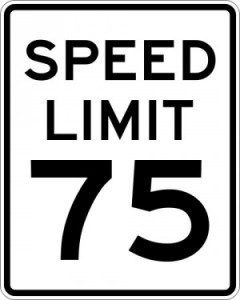Personal Injury Telemarketing: Speed Limits Going Up?
 Leadfoots everywhere can rejoice in what seems to be a flood of legislative activity to raise speed limits on major highways across America. Others like safety groups and personal injury telemarketing professionals may have a more guarded reaction, thinking about how these changes may affect auto accident injury rates.
Leadfoots everywhere can rejoice in what seems to be a flood of legislative activity to raise speed limits on major highways across America. Others like safety groups and personal injury telemarketing professionals may have a more guarded reaction, thinking about how these changes may affect auto accident injury rates.
Brand-new coverage from USA Today July 22 shows five states going with higher-mph signage on major highways after changes at the Lone Star State, where the Texas Legislature raised some speed limits to 85 miles an hour last year.
According to these reports, Ohio, Utah and New Hampshire have decided to up the ante on freeway speeds, while Maine and Illinois are still studying the potential effects of speed limit changes.
The History of Speed Limits
One thing that many drivers may not know is that federal speed limits imposed in the 1970s were not done based on detailed auto accident fatality studies, but on research around fuel economy. Many years before auto manufacturers started to produce greener and more efficient vehicles, long lines at gas pumps and other political pressures caused the American government to mandate speeds around 55 mph, speeds that have been shown to greatly increase fuel efficiency across the board. Every 5 miles above this benchmark means more gasoline burned, and getting up to the 70s and 80s requires a prodigious rate of fuel consumption.
Despite this fact, agencies like the Insurance Institute for Highway Safety or IIHS show that the majority of states have speed limits of 70 miles an hour or higher on some roads.
Auto Accident Injury Statistics
According to the IIHS, higher speed limits don’t just lead to more gas consumption, they can also be dangerous. Agency spokespeople have indicated that accident fatality statistics are closely linked to top speed limits, where speed is a contributing factor in around one-third of all fatal car accidents in numbers released by the National Highway Traffic Safety Administration. Some states have done their own research which challenge specific case studies on these assumptions, showing for example, that drivers tend to set their own reasonable road speeds on some highways.
In all actuality, speed limit changes that lift top MPH can have a big impact on many kinds of businesses including personal injury law, personal injury telemarketing and various kinds of emergency care facilities or other kinds of providers like chiropractic offices. Many of these care offices and other businesses may see an influx of auto accident injury patients as state officials act on convenience or other concerns, rather than strict responses to provided statistics showing roadway control as a major factor. That’s not to say that states are abandoning their responsibility for creating safe, controlled infrastructure for drivers – however, the controversy over higher speed limits may be one aspect of a highly regulated transportation and insurance industry that isn’t going away anytime soon.